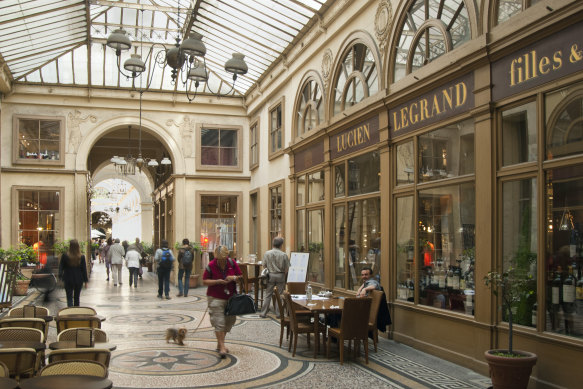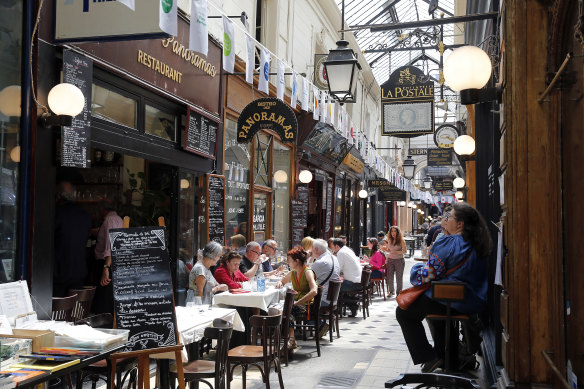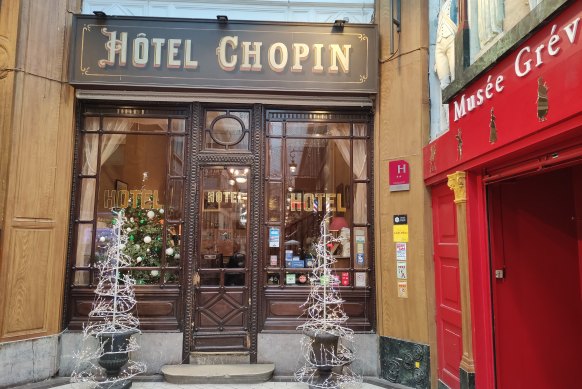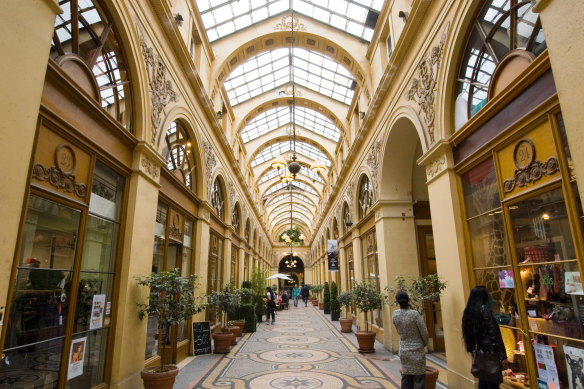Move over, Melbourne: Here’s how Paris does laneway culture
Unlike the major Parisian landmarks that capture your gaze from afar, the city’s passages couverts are discreet and easy to miss. Back in the mid-1800s, at the height of their popularity before the big department stores arrived, about 150 of these covered passages threaded through the French capital. Only a few dozen remain, but they’re still inviting places in which to stroll, shop, eat, drink and people-watch – and handy for escaping the rain or the searing summer sun.

Arcade life in Paris.Credit: iStock
Some passages are more shabby than chic, while others are in better shape, with the original architecture nicely restored and a blend of old-fashioned and contemporary businesses keeping these arteries alive. Especially beguiling are the passages of the Grands Boulevards district, next to the Metro station of the same name, where the 2nd and 9th arrondissements meet. Portrayed in Nana, an 1880 novel by the renowned French writer Emile Zola, the Passage des Panoramas was one of Paris’ first passages couverts, inaugurated at the turn of the 19th century. It’s still open daily, from 6am to midnight.
Ambling through on a weekday lunchtime, I find the vibe bygone yet vibrant. Above classic, wood-panelled shopfronts, vintage signage advertises old print-makers and chocolatiers, while window displays flaunt stamps, coins and Parisian postcards from yesteryear. Menus also catch the eye, with restaurant tables spilling out onto the passage’s semi-scuffed mosaic floor. Parisians of all generations, plus tourists who’ve stumbled across or sought out this passage, are tucking into everything from shawarmas and gyozas to pizzas and modern Gallic bistronomy.

The Passage des Panoramas, the oldest covered passage in Paris, built in 1799.Credit: Getty Images
Several places also have cosier indoor dining, including Canard & Champagne, which, as its name suggests, excels at duck dishes (and bubbly), while neo-bistro Astair entices with a great wine list and dishes such as Provencal-style octopus, Charolais beef tartare and creme brulee. Sporting red-and-white chequered tablecloths, Bar des Varietes takes its name from the theatre established next to this passage in 1807 (which is still staging plays), while Victoria Station is a train-themed eatery with lamplit, velvet-lined “wagon” booths that evoke the Orient Express. Winding off the passage’s main strip are adjoining galeries (arcades), some promising more food (Moroccan couscous or tagine, perhaps), others leading to dead, vacant ends begging for some TLC.

Hotel Chopin is tucked away inside Passage Jouffroy.
Separated by the traffic-thronged Boulevard Montmartre, Passage Jouffroy is worth crossing the street for. It’s a newer, wider extension of the Passages des Panoramas with a refurbished glass-and-metal canopy, neat stone paving and polished antique frontages. A clock hangs above Hotel Chopin, which opened in 1846 but changed its name in 1970 to honour the legendary composer, who is said to have regularly walked through here on his way home. (He is rumoured to have used the hotel as a rendezvous spot for his long-running affair with the author George Sand.) Next door, meanwhile, behind a bright red facade, the Grevin Museum is Paris’ version of London’s Madame Tussauds. It contains waxworks of more than 200 historic and living French and global celebrities, from King Charlemagne to Zinedine Zidane.
Browse-worthy stores will have you crisscrossing Passage Jouffroy. Pain d’Epices, touted as Paris’ oldest toy shop, is stuffed with doll houses, board games and teddy bears. Other shop windows have Tintin and Asterix comics, retro maps and travel posters, and prints of Parisian cityscapes past and present. You may spot craftspeople at work too. Peeking into the Seigle Galerie & Atelier – named after a late husband-and-wife pair of 20th-century artists – I see a woman at her easel, brush in hand, surrounded by paintings.

Galerie Vivienne with its domed glass roof.Credit: iStock
More temptations– think secondhand books, escargots and Korean brunch – may lure you into the neighbouring Passage Verdeau, and there are even more passage-hopping opportunities within a 15-minute walk. South Asian restaurants sprinkle Passage Brady, dubbed “the Little India of Paris”. Statues of the ancient Egyptian goddess, Hathor, guard the entrances of Passage du Caire (Cairo), a somewhat neglected 1798 arcade that has had new life breathed into it by the funky new Hotel du Sentier. And just north of the Palais-Royal, luxury boutiques, upscale cafes and bistros and a ravishing domed glass roof make Galerie Vivienne a seductive proposition.
THE DETAILS
FLY
Emirates flies to Paris from Sydney and Melbourne via Dubai. See emirates.com
MORE
The writer travelled at his own expense.
Sign up for the Traveller Deals newsletter
Get exclusive travel deals delivered straight to your inbox. Sign up now.